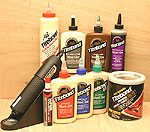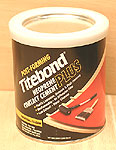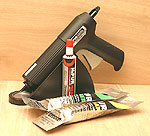
 |
If Titebond can't glue it, it's probably not woodworking!
Click image to enlarge |
The Titebond Glue Family
Nine ways to get stuck and like it!
Text & Photos by Tom Hintz
Note: I'd like to thank Dale Zimmerman, Technical Specialist with Franklin International for his help with this story. Dale's participation and the technical data he provided (and explained) made this story possible.
Modern wood glues are stronger than ever because of the extensive chemistry, engineering and testing that goes into their development. Franklin International, the maker of Titebond glues, is a leader in the woodworking adhesive industry because of their expertise in all of those areas. Woodworkers everywhere depend on Titebond glues, with good reason, when building their projects.
Testing glues accurately is very difficult, requiring high-tech equipment and a tightly controlled environment. These strict (say expensive) controls and procedures insure the consistency necessary to produce reliable data that can be used to compare the various types of glue.
Strength Testing
Glues are tested following ASTM D-905 guidelines. ASTM is the American Society for Testing and Materials and D-905 is the Standard Test Method for Strength Properties of Adhesive Bonds in Shear by Compression Loading.
Hard maple is used in all of these tests. While certainly not the easiest wood to glue, it is very consistent.
Blocks of hard maple are coated with glue and assembled following label directions, then allowed to cure fully. Some of the blocks are subjected to increasing shear loads until they fail at room temperature. Others are "soaked" in a 150-degree oven for an extended period of time to be sure that temperature is attained throughout the sample. It is then subjected to the compression loading until failure while still at that temperature.
The difference in the PSI ratings between the room temperature and heated tests shows that glues react to heat differently. Glues showing substantially lower PSI ratings in the heated test are more likely to soften during sanding and gum up the sandpaper.
That reaction to heat obviously weakens the joint as well. These figures can also provide insight on how useful heat would be to take a cured joint apart when necessary. Though ambient heat is not a significant problem for most woodworkers, it could be a factor for some outdoor projects that reside in sunny areas.
Percentage of Wood Failure
Another measured factor in the shear tests is how much of the failed joint is wood and as opposed to glue. Naturally this ratio will vary with the softness of the wood but the test data, gained using hard maple for all of the glue varieties, provides a consistent baseline with which to compare one type of glue to another.
In the test data, the per-cent of wood failure indicates the amount of wood that failed when the sample broke. The rest is considered failure of the glue itself. This data is provided for both the room temperature and 150-degree versions of the test. If you are building something that will sit on a windowsill, in a sun room or a car (camper), this heat related information could be important.
In light of the testing complexity, and the fact virtually every woodworker in the world already knows about Titebond glues, this is less a review and more a compilation of information. It is my hope that this information will help you select the proper Titebond product for your application.
Note: Open times at 70-degrees and 50-percent humidity
|
 Titebond Original Wood Glue Titebond Original Wood Glue
Type - Aliphatic resin emulsion
Color - Wet, Yellow - Dried, Translucent
Bond Strength:
Room temp - 3,600 psi - 77% wood failure
150-degrees - 1,600 psi - 10% wood failure
Minimum application temp - 50 degrees
Open time - 5 minutes
Storage life - 12-months, tightly closed at 75-degrees
Clamp pressure - (Approx ) Softwoods,100-150 psi - Medium woods, 125-175 psi - hard woods, 175 - 250 psi.
Cleanup - Wet - Damp cloth, Dried - Scrape
Good all-around glue for indoor projects, most types of wood & wood products, general assembly and repair. Unaffected by finishes, not for exterior use.
|
 Titebond II Premium Wood Glue Titebond II Premium Wood Glue
Type - Cross-linking polyvinyl acetate
Color - Wet, Honey cream - Dried, Translucent
Bond Strength:
Room temp - 3,750 psi, 72% wood failure
150-dgrees - 1,750 psi, 6% wood failure
Minimum application temp - Above 55-degrees
Open time - 5 minutes
Storage life - 12 months, tightly closed at 75-degrees
Clamping pressure - Soft wood, 100-150 psi - Medium wood, 125-175 psi - Hard wood, 175-250 psi.
Clean up - Wet, damp cloth - Dried, scrape
A more versatile general indoor/outdoor use glue. This was the first one-part glue to pass the ANSI Type 2 water resistance tests but not for submersed or below-waterline use. FDA approved for indirect food contact.
|
 Titebond III Ultimate Wood Glue Titebond III Ultimate Wood Glue
Type - Advanced Proprietary Polymer
Color - Liquid, Tan - Dried. :Light brown
Bond Strength:
Room Temp - 4000 psi, 57% wood failure
Minimum application temp - 47-degrees
Open time - 10-minutes
Storage life - 12 months, tightly closed at 75-degrees
Clamping pressure - Soft Wood, 100-150 psi - Medium wood, 125-175 psi - Hardwood, 175-250 psi
Clean up - Wet, damp cloth - Dried, scrape
Good indoor/outdoor glue, passes ANSI/HPVA Type 1 water resistance though not for submersed or below waterline applications. Has a longer open time and is FDA approved for indirect food contact.
|
 Titebond Extend Wood Glue Titebond Extend Wood Glue
Type - Aliphatic resin emulsion
Color - Liquid, Yellow - Dried, Yellow
Bond Strength:
Room Temp - 3,510 psi, 81% wood failure
150-degrees - 3,120 psi, 61% wood failure
Minimum application temp - 40-degrees
Open time - 15-minutes
Storage life - 6 months, tightly closed at 70-degrees
Clamping pressure - High pressure laminates - 30-80 psi, Soft Wood, 100-150 psi - Medium wood, 125-175 psi - Hardwood, 175-250 psi
Clean up - Wet, damp cloth - Dried, scrape
Not intended for exterior or wet applications. While Extend can be used for most common materials, the long open time makes it a good choice for complicated joinery applications such as dovetails and finger joints.
|
 Titebond Molding & Trim Glue Titebond Molding & Trim Glue
Type - Thixotropic polyvinyl acetate
Color - Liquid, Beige - Dried, Beige
Bond Strength:
Room Temp - 3000 psi, 7% wood failure
150-degrees - 650 psi, 0% wood failure
Minimum application temp - 55-degrees
Open time - 3 to 5-minutes
Storage life - 12 months, tightly closed at 75-dgrees
Clamping pressure - Soft Wood, 100-150 psi - Medium wood, 125-175 psi - Hardwood, 175-250 psi
Clean up - Wet, damp cloth - Dried, scrape
Designed for interior trim work, this glue is not meant for outdoor or wet applications. It is thick, resists runs and drips and helps fill small gaps and cracks. The short open time is ideal for installing trim and moldings in the house or on woodworking projects.
|
 Titebond Liquid Hide Glue Titebond Liquid Hide Glue
Type - Natural protein emulsion
Color - Liquid, Amber - Dried, Translucent
Bond Strength:
Room Temp - 3,591 psi, 72% wood failure
150-degrees - 3,207 psi, 59% wood failure
Minimum application temp - 70-degrees
Open time - 10-minutes
Storage life - 12 months, tightly closed at 75-dgrees
Clamping pressure - Soft Wood, 100-150 psi - Medium wood, 125-175 psi - Hardwood, 175-250 psi
Clean up - Wet, damp cloth - Dried, scrape
Unlike the old hide glues that had to be melted, the Titebond version remains a liquid and is ready to use right out of the bottle. This Hide glue sands easily, resists "creep" as good as anything and can be used to produce the old fashioned "crackle effect" on wood.
|
 Titebond Polyurethane Glue Titebond Polyurethane Glue
Type - Polyurethane
Color - Liquid, Brown - Dried, Yellow
Bond Strength:
Room Temp - 3,500 psi, 60% wood failure
150-degrees - 3,000 psi, 50% wood failure
Minimum application temp - 50-degrees
Open time - 20 to 25-minutes
Storage life - 12 months, tightly closed at 75-dgrees
Clamping pressure - High Pressure Laminates, 30 - 80 psi, Soft Wood, 100-150 psi - Medium wood, 125-175 psi - Hardwood, 175-250 psi
Clean up - Wet, mineral spirits - Dried, scrape or sand
100% waterproof (passes ANSI type 1 & 2), sands very well, bonds nearly anything to anything and when applied correctly is very strong with little heat-related weakening of the joint.
While the obvious uses are for outdoor projects, we have used polyurethane glues to secure dovetail joints in exotic woods because of how easily excess glue (essentially foam) scrapes and sands away without interfering with finishes applied afterwards.
|
 Titebond Post-Forming Neoprene Plus Contact Cement Titebond Post-Forming Neoprene Plus Contact Cement
Type - Polychloroprene latex
Color - Liquid, Amber - Dried, Translucent
Application temperature range - 60 to 90-degrees
Open time - up to 8 hours
Storage life - 12 months, tightly closed at 75-dgrees
Clean up - Warm soapy water to clean tools and excess adhesive when wet. Dried adhesive, use a petroleum-based or biodegradeable citrus-based solvent/cleaner, following the manufacturers instructions for use and testing in an inconspicuous area.
Non-flammable, highly resistant to water and heat this is a good choice for applying laminates in woodworking, especially in small shops because it also lacks the odors formerly associated with contact cements.
This neoprene adhesive is the coming thing in todays world concerned with volatile chemicals. It appears Titebond is ahead of the field somewhat in developing this contact cement but the rest are sure to follow as laws are enacted banning the old style solvent-based contact cements.
|
 Titebond HiPur Polyurethane Hot Melt System Titebond HiPur Polyurethane Hot Melt System
Type - Polyurethane Hot Melt Cartridges
Color - Hot, Clear - Cooled, Opaque
Interior/Exterior Use
Waterproof
Open Times:
WW30, 30 seconds - WW60, 60 seconds - MP75, 75 seconds - MP300, 5 minutes
Bond Strength
WW30, 10 min. - 650 psi, 1 hr. - 1090 psi, 24 hrs, 1360 psi
WW60, 10 min. - 600 psi, 1 hr. - 1130 psi, 24 hrs - 1480 psi
MP75, 10 min. - 270 psi, 1 hr. - 600 psi, 24 hrs - 900 psi
MP300, 10 min. - 118 psi, 1 hr. - 478 psi, 24 hrs - 1016 psi
Clean up - Hot, scrape with putty knife, etc. - Cooled, must be chiseled or sanded away
This is a new product for the home woodworker market and one that will serve many purposes. It comes in a kit with a very nice , German-made Steinel heat/application gun.
Woodworkers will find many uses for this system including tacking parts temporarily for application of other fasteners, permanently installing smaller moldings & trim pieces, jig building and many more.
|
Do you have a comment about this page? - Email Me! |
|
|











